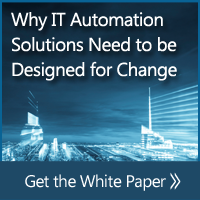Five IT Automation Predictions for 2014
The top five predictions for the job scheduling and IT Automation market in 2014.

In the past twelve months we continue to witness the evolution of IT into something bigger, faster and more adaptable than we could have ever imagined. IT automation is no exception to this rule and will continue to become more nimble in order to satisfy the accelerating pace of business and the resulting demands of IT. IT automation vendors will continue to respond to these demands in 2014. Here are the top 5 trends we see reshaping our marketplace:
- The Continued Consolidation of “Point” IT Automation Solutions – IT organizations have traditionally taken a “siloed” approach to IT automation by implementing platform or departmental specific automation solutions. For example, job scheduling for batch processes, a runbook automation tool for IT operations and another tool for automating FTP, database operations, ETL and other datacenter processes. As processes become dependent on other processes and span the entire IT organization, consolidating these silos of automation within a single solution becomes necessary.
- Predictive Analytics – Today, IT automation solutions can proactively predict “spikes” in workload execution to provision resources; the next step is to provide additional “what-if” predictive capabilities that allow you to forecast and plan workflow execution across a variety of systems and platforms. IT organizations should have the ability to an execution plan of past and future workflow instances based on changes to the workflow and/or changes to the machines executing the jobs. The forecast capability, when combined with that ability to tie workflows to business deadlines/SLAs, will provide an IT organization with an unparalleled and simplified way of planning and managing workloads and resources across the enterprise.
- Built for Change – Legacy job scheduling and automation solutions have traditionally relied on static, script-based interfaces that have made building and updating complex workflows that span various applications, platforms and departments a time-consuming affair. In today’s 24/7, Internet-driven world, whereby businesses are driving the IT organization to build new processes and update existing ones to respond to market pressures, using scripts simply doesn’t cut it. The next generation of IT automation solutions will need to be designed for change by providing Web 2.0 interfaces that allow developers to more easily build and manage complex processes that span the IT organization. These newer, more modern interfaces will allow developers to reduce their dependency on scripting and dynamically build complex workflows leveraging interfaces to view the entire IT infrastructure and build and automate workflows that span it.
- Self-Service Automation – These simplified, Web-based user interfaces will also help drive the continued expansion of self-service automation. The idea is that an end user – either IT or the business – can use an IT automation solution to choose from a service catalog and initiate a process or workflow themselves – without the need to involve someone from IT operations, therefore improving IT service levels for the business. Ideally, end users can plan the execution of business processes themselves, and workload automation will serve as the underlining engine that automates the provisioning of resources and applications to achieve business objectives. Leading IT organizations have begun adopting this strategy to improve service levels, but 2014 will see this strategy start to go mainstream.
- DevOps Automation – DevOps requires usually disparate groups (development, QA and IT Operations) operating with a singular purpose to achieve bringing a release more quickly and efficiently. As such, there is an automation requirement to ensure the reusability of deployment tasks and reduction of deployment errors due to manual intervention. Traditionally, application development teams leverage scripting for the automation and management of build and release processes. On the other side of the fence you have IT operations and datacenter teams responsible for the provisioning and management of the underlying infrastructure resources on which these new applications reside. To automate their respective processes, they rely on scripts or platform-specific scheduling tools. For example, IT operations will typically rely on VMware’s native scheduling tool for automating VMware tasks, such as provisioning and cloning instances. IT automation will start to serve as an “architectural” automation solution that unifies “point” scheduling tools and scripts to provide a single automation framework that automates the long list of discrete tasks needed to build, deploy and test Web and mobile applications.
Download the Guide
ActiveBatch Workload Automation provides an intuitive user interface so users can easily build and monitor processes that orchestrate data center workflows, IT operations and infrastructure tasks, business applications, batch jobs, and more. With programmatic integrations and low-code API accessibility, users can coordinate data, dependencies, and resources between IT and business systems. See what you can accomplish with ActiveBatch.








